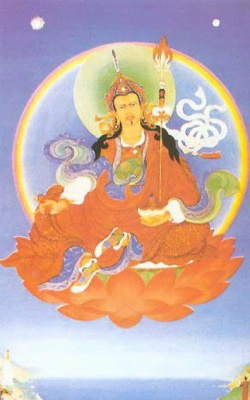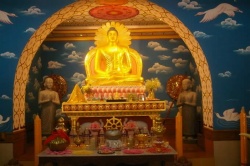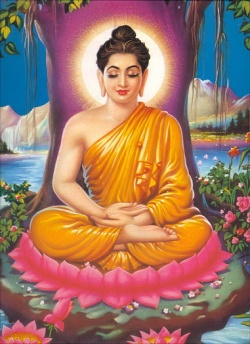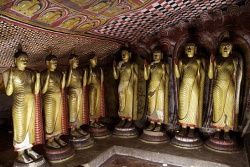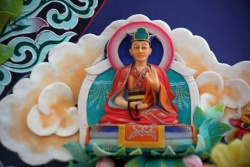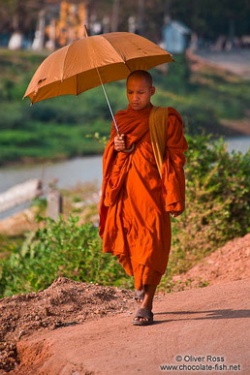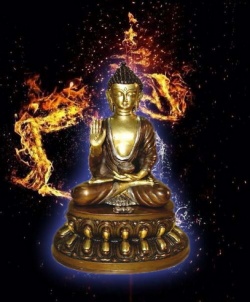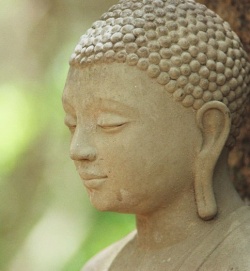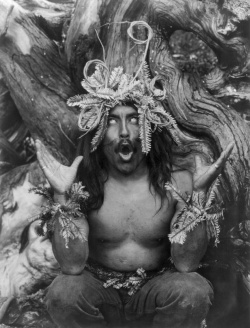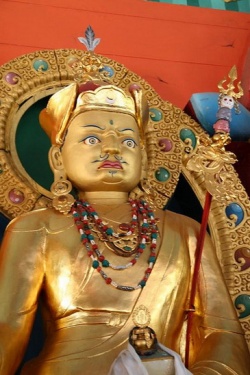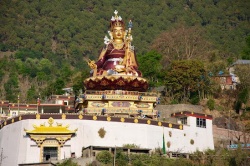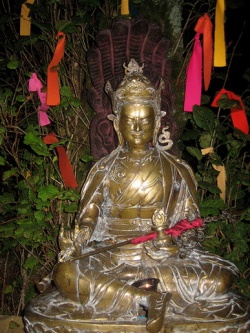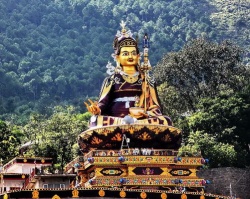A Brief History of the Nyingma
The Nyingma School has an unbroken lineage of enlightened masters of Mantrayana and Sutrayana from the present time back to the disciples of Shakyamuni Buddha.
Literally it is known as the school of the ancient ones.
More than 2,500 years ago Shakyamuni Buddha, the fourth Buddha, ushered in the auspicious time (kalpa) in which we still live and which will see a thousand Buddhas manifest in this world.
He revealed himself to be a Buddha by fulfilling the twelve deeds that all Buddhas perform:
"Leaving Tusita heaven (dGa.ldan) for this world in the form of an ash white elephant
Entering into the womb of his mother
Taking birth in Lumbini, and then taking seven steps in each of the four directions
Learning the arts, such as writing, mathematics, archery etc
Engaging in sports with other young men and enjoying the company of his consorts
Abandoning the princely life at the age of 29 to become a self ordained monk
Enduring many hardships for six years by the river Nairanjana
Sitting beneath the bodhi tree at Bodhgaya
Defeating hosts of demons that night
Attaining buddhahood at dawn
Turning the Wheel of Dharma at Sarnath
Passing into Nirvana."
He turned the Wheel of Dharma three times. That is he gave three distinct cycles or cannon of teaching:
First in Sarnath, Buddha taught the four noble truths (bDen.pa bzhi) to the five noble ones (lNga.sde bzang po) being suffering, the cause of suffering, the end of suffering and the path leading to the end of suffering.
This is the basis of the Hinayana.
Second at Vulture’s Peak in Rajgir he taught the perfection of wisdom (Prajna Paramita, Tib. SNying-mDo or The Heart Sutra) being characteristiclessness or "emptiness".
Form is emptiness and emptiness is form.
He taught this to a mixed audience of men, women, sramaneras, bhiksus, bhiksunis, bodhisatvas (including Manjushri, Avalokitesvara, Vajrapani and Maitreya).
Finally he taught the doctrine of absolute truth to supernatural beings, gods, bodhisattvas, nagas, raksas, raksasas and human beings.
The Buddha left 84,000 kinds of teachings, enough for an appropriate teaching for every kind of mind.
These can be classified in three, nine, twelve, fourteen and fifteen yanas or vehicles.
The first cycle of teachings was concerned with the Hinayana, the second and third with Mahayana. See 9 YANAS
Shravakayana teachings form the basis for all Buddhist study and practice, and the Bodhisattvayana teachings are the basis of vision and practice of the Great Vehicle, the Mahayana.
The Bodhisattvayana includes the Sutrayana teachings such as Prajnaparamita and Tathagatagarbha and the Mantrayana teachings revealed in thousands of Tantras.
Tantrayana or Vajrayana traditionally was taught in private first at the request of King Indrabodhi of Oddiyana (O.rgyan).
He taught chosen disciples of high merit how to transform phenomenal appearance into a pure mandala.
In order to teach this he emanated the Guhyasamaja mandala (gSang.ba ‘Dus.pa), gave empowerment of this and then gave the tantric teachings. Thus it was taught apart from the three turns of the Wheel of Dharma.
He also prophesied that he would in a future time emanate to teach the Vajrayana.
In the Mahaparinirvana Sutra (Mya.ngan las ‘das.pa’I mdo) he said he would be reborn in a lake.
This was fulfilled by the Birth of Padmasambhava (Pa.ma ‘byung.gnas) also known as Pema Jungne, the lotus Born Lama and Guru Rinpoche.
The Hinayana view is that Shakyamuni transmitted his teachings to seven accomplished disciples: Odsung, Kungawo, Shane Göchen, Nyerbe, Phagpa Dhidhika, Nagpopa and Lgthong.
The Mahayana account is that it was transmitted through the boddhisattvas including Maitreya, Manjusri etc as intermediaries to Nagarjuna, Aryadeva, Asanga, Vasubandhu, Gunaprabha, Sakyaprabha, Dignana and Dharmakirti.
(Tibetan: Ludrup, Phagpa Lha, Thogme, Yingyen, Yönten Od, Shakya Od, Choglang and Chödrag); to the two wonderful teachers Santideva ([[Zhi.ba[Lha]]) and Candragomin (Tsan.dra.go.mi); to the four great teachers, Mahabrahamana Saraha(Dramze Chenpo Saraha), Dharmapala (Khepa Chenpo Palden Chökyong), Rahula (Tsunpa Chenpo Drachen Dzin) and Virya (Lobpön Chenpo Pawo).
The Tantric Vajrayana teachings were transmitted through Vajrapani and the eighty-four mahasiddhas.
The Vajrayana is classified within Nyingma as Outer and Inner Tantras.
The Outer Tantras are Kriya, Carya and Yoga Tantras.
The Inner Tantras are Mahayoga, Anuyoga and Atiyoga.
The inner Tantras belong specifically to the Nyingma tradition.
It was the first two of these that were passed on to King Indrabodhi.
They were transmitted through the Vidyadaras Kukkuraja, Lilavajra, Buddhaguhya, Padmasambhava and others.
Atiyoga was passed to the first human Vidyadhara dGa’-rab rDorje to Manjusrimitra, Sri Simha, Jnanasutra, Vimalamitra, Padmasambhava and others.
Five years after the Parinirvana of Shakyamuni Buddha, as he predicted, Guru Padmasambhava, the Lotus Born Lama arises in Oddiyana to transmit the Mantrayana teachings known as the Inner Tantras: Mahayoga, Anuyoga, and Atiyoga.
28 Years After the Parinirvana of the Buddha, King Indrabodhi of Sahor, also known as King Dza,
received the transmission of the Mahayoga and Anuyoga Tantras from the Bodhisattva Vajrapani.
He began a long lineage of Vidyadharas (Knowledge Holders) who realised and transmitted these teachings for many centuries in India.
Garab Dorje was born 166 Years after Buddha’s Parinirvana in Oddiyana, northwest of India.
He was an incarnation of Vajrasattva.
He was the first human to teach the Atiyoga Tantras.
He passed the Atiyoga to Manjushrimitra, an emanation of the Boddhisattva Vajrapani between the first and third Century CE.
In turn he transmitted them to [[Shri] Simbha]].
He realised them and passed them to Jnanasutra, Buddhaguhya, and to the masters who brought them to Tibet: Vimalamitra, Padmasambhava, and Vairotsana.
During the 7th-8th CE Lilvajra transmitted the Mahayoga Tantras to Buddhaguhya, Padmasambhava, and Vimalamitra who later carried the teachings to Tibet.
Possibly some of these teachings reached Tibet by the 5th Century CE.
Nevertheless, it was not until the 8th Century CE that Buddhism began to be established in any systematic and general way.
King Trisong Detsen (b.circa 742 CE) invited an Indian abbot, Shantarakshita to Tibet to establish a great monastery and after encountering difficulties on his advice he solicitated the help of a tantric practitioner, Padmasambhava.
Padmasambhava is known as the second Buddha throughout the Himalayan region.
His legacy is found throughout the region and in many caves he used for meditation one can still see handprints and footprints he impressed into solid rock such was the extraordinary power of his realisation.
Modelled on the famous Otantapuri Temple in Bihar, Samye Monastery was eventually completed.
The sixty-four hundred thousand teachings of rDzogs-pa-chenpo obtained from Bodhgaya in India and elsewhere were introduced to Tibet by Padmasambhava.
Under the direction of Padmasambhava, Vimalamitra, and Vairotsana oversee the translation of the Mahayoga, Anuyoga, and Atiyoga Tantras into Tibetan and more than a hundred each Tibetan and Indian panditas translated most of the then known Buddhist teachings into Tibetan.
Buddhaguhya the renowned Pandita of Nalanda transmitted the Mahayoga teachings to Tibetan disciples such as Nyags Jnanakumara, who brought them to Tibet.
The inner tantras were transmitted from generation to generation in two ways:
The bKa’-ma (long transmission from realised master to student which might be an unbroken chain of individuals over a long period of time and
the gTer-ma (short) transmission.
The latter is derived from teaches concealed by Padmasambhava and his spiritual consort Yeshes Tsogyal to be discovered when the circumstances were right by tertons (gTer-stons).
They are therefore a very direct communication and are appropriate to circumstances now whereas the long transmission offers the confidence of knowing that it has worked and been realised by a succession of people before.
The Treasure transmission comprises the innumerable treasure texts revealed by subsequent Treasure Masters, which were hidden by Guru Rinpochey himself in 9th century as well as numerous teachings later revealed through enlightened minds and meditative visions of Nyingma masters.
Hundreds of masters have appeared who have revealed treasures.
Among them, Nyangral Nyima Özer (1124-92), Guru Chowang (1212-70), Dorje Lingpa (1346-1405), Padma Lingpa (b.1405) and Jamyang Khyentse (1820-1892) are renowned as the Five Kings of the Treasure Masters.
Their revealed treasures concern, among others, the cycle of teachings and meditations related to Avalokiteshvara, Guru Rinpochey's sadhanas, the Dzogchen teachings, the Ka-gyey cycle of teachings, the Vajrakila or Phurba cycle of teachings, medicine and prophecies.
Consequently, as well as the standard Mahayana Buddhist canon of the Kangyur and Tangyur, many further teachings may be found in the Collection of a Hundred Thousand Nyingma Tantras, compiled in thirteenth century by Tertön Ratna Lingpa (1403-1473) and organised by Kunkhyen Longchen Ramjampa (1308-1363).
Besides this, numerous works such as the sixty volumes of the Rinchen Terdzod compiled by Kongtrul Yonten Gyatso (1813-1899) and the writings of Rongzom, Dodrupchen, Paltrul, Mipham and many others have added to the rich collection of Nyingma literature.
Yeshes Tsogyal, King Tri-song De-tsen, Vairocana the Translator, gNyags Jnanakumara, Sang-gye Yeshe and Rin-chen Chogother 25 disciples of Padmasambhava were charged with the responsibility to pass the Dharma on to future generations.
They have all repeatedly been reborn as masters of kama and terma to guide successive generations of practitioners and protect the Nyingma School even to the present day.
Unlike the other Buddhist traditions the Nyingmapas did not become institutionalised until much later in their history.
Apart from Samye, no major monasteries were built until the 12th century.
This first period was known as the Early Translation, Ngagyur (sna ’gyur) and those who practiced the tradition that this gave rise to were eventually to be called the Nyingma (rnying ma, tr. Ancient Ones) to distinguish them from the followers of later traditions which later evolved known as the Sarma (gsar ma).
Following the murder of the last Dharma King, Ral-pa-can in 836 CE, his brother, King Glangdarma, waged war on Buddhism and the monasteries were destroyed.
Protected by the disciples of Padmasambhava and Vimalamitra, Buddhism survived in Tibet through the lineages of ordained lay yogins or ‘ngakpas and ngakmos’.
The Vinaya (monastic) sangha was preserved by three monks, sMar, Rab and gYo who smuggled sacred texts to the remote province of A-mdo where they could be kept safely.
The official persecution only lasted about a dozen years but Tibet remained in confusion.
Tibet had fragmented into ten small kingdoms.
It wasn’t until the tenth century CE that the ruined monasteries and temples started to be restored.
Slowly practitioners started crossing to and from India and Tibet.
Of these the most important was Smrtijnanakirti (892 – 975).
At Ukpalung Monastery in Central Tibet, the Nyingma master Zurpoche Shakya Jungney collected thousands of texts during the 10th Century CE, classifying and arranging Tantras together with their commentaries, practice and ritual manuals.
Led by Rinchen Zangpo (957 – 1055) who had studied in Kashmir in the 10th and 11th Centuries CE a second wave of translation and interpretation occurred resulting in the New Translation period of the Sarma.
The resulting traditions of this second wave included the Kadam, (later to evolve into the Gelug), Sakya, Kagyud, Shangpa Kagyud, Chöd and Shije, Kalachakra and Urgyen Nyendrub.
Together with the Nyingma these are sometimes referred to as the Eight Chariots of Spiritual Accomplishment (sgrub brgyud shing rta brgyad).
All the major Sutrayana teachings of the Buddha and the sastras of the Mahapanditas were preserved in revised and modified translations by the new schools and constitute a heritage shared by all schools.
The texts of the Inner Tantras which were translated in the early period are the unique heritage of the Nyingma School.
Nechung Monastery was built in Central Tibet by Chokpa Jangchub Palden and Kathok Monastery was founded in Kham by Ka Dampa Desheg (1112-92 CE) in 1159 CE.
From the 15th century onwards, great monastic universities were built, such as Mindroling, founded in 1676CE by Rigzin Terdag Lingpa, otherwise known as Minling Terchen Gyurmed Dorje (1646-1714CE) and Dorje Drag founded in 1659 CE by Rigzin Ngagi Wangpo in central Tibet; and Palyul established by Rigzin Kunsang Sherab in 1665 CE;
Dzogchen built by Dzogchen Pema Rigzin in 1685 CE and Zhechen established by Zhechen Rabjampa in 1735 CE, all in Kham province.
Dodrupchen and Darthang monasteries were established in Amdo.
In the 15th Century CE, the Inner Tantras preserved at Ukpalung Monastery were gathered together by Nyingma Master Ratna Lingpa into a collection known as the Nyingma Gyudbum.
Orgyen Terdag Lingpa and Lochen Dharmashri collect ancient Nyingma Kama texts together thus preserving them in the 17th Century CE.
In the 18th Century CE Kunkhyen Jigme Lingpa and Gertse Mahapandita verify the authenticity of the Nyingma Gyudbum inner tantra texts and compose catalogues and histories for a blockprint edition made at Derge, eastern Tibet.
During the 19th Century CE Jamyang Khyentse Wangpo, Kongtrul Lodro Thaye, and Chogyur Dechen Lingpa assembled thousands of Terma treasure texts from throughout Tibet, creating a collection known as the Rinchen Terdzod.
Monastic institutions re-established in exile include Thekchok Namdrol Shedrub Dargye Ling, in Bylakuppe, Karnataka State; Ngedon Gatsal Ling, in Clementown, Dehradun;
Palyul Chokhor Ling and E-Vam Gyurmed Ling in Bir, and Nechung Drayang Ling at Dharamsala, and Thubten E-vam Dorjey Drag at Shimla in Himachal Pradesh, India.
The Nyingma classifies the teachings into 9 yanas or vehicles.
These can each be considered both as being complete within themselves having a ground, a path and a fruit, or alternatively as steps along a continuum towards the Great Perfection.
It is also said that each contains all of the other yanas.
